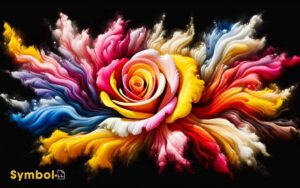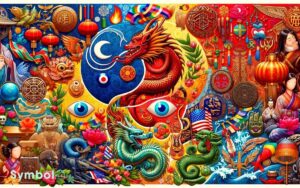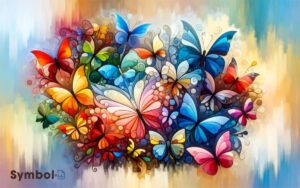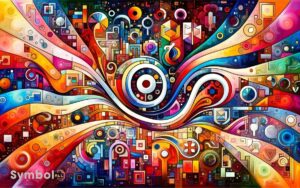What Does Color Green Symbolize? Vitality, Growth, & Renewal
You often see green enveloping the natural world, symbolizing vitality, growth, and renewal. It’s not just about plants thriving; green reflects the essence of life itself, embodying balance and harmony within ecosystems.
Beyond nature’s cycle, green denotes wealth across cultures, tied historically to prosperity and modernly to sustainability. In branding, it conveys trust, growth, and a commitment to eco-friendly practices.
Importantly, green fosters well-being by reducing stress, enhancing mood, and promoting mental peace. It bridges vibrant landscapes and our inner need for balance, encouraging a deep environmental connection.
This tapestry of meanings reveals green’s profound impact, inviting further exploration into its multifaceted symbolism.
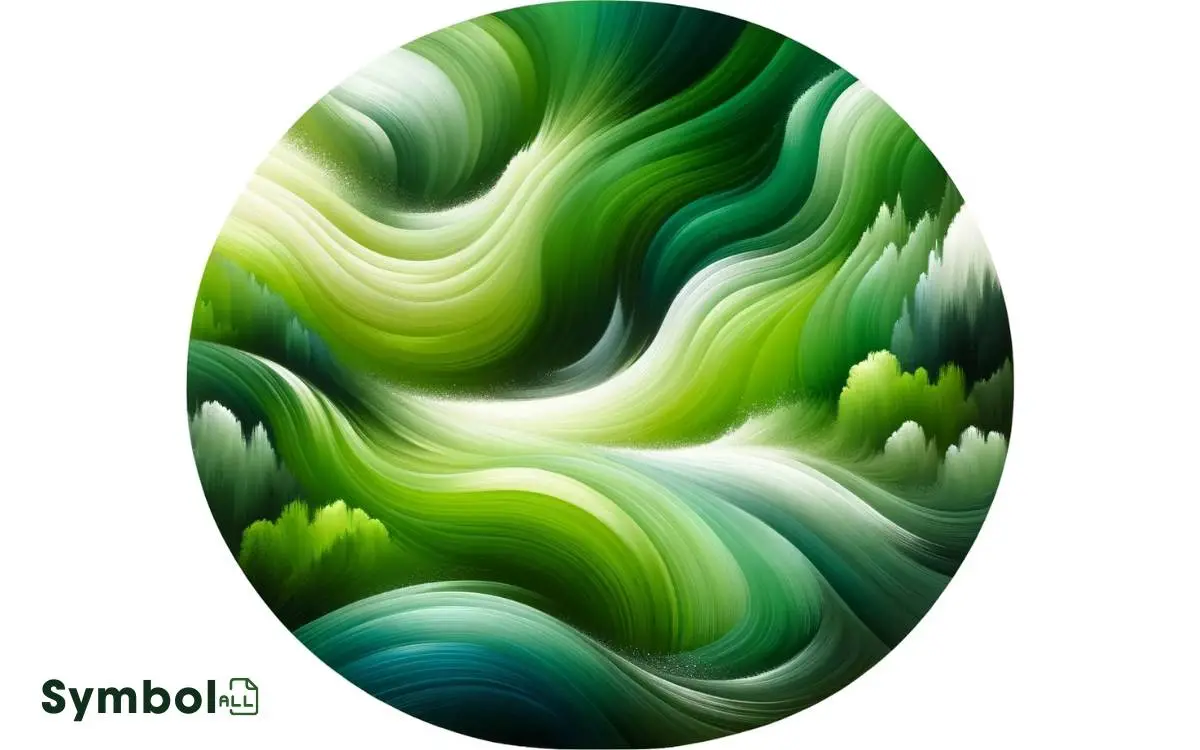
Key Takeaway
Nature and Vitality
Green serves as a universal emblem of nature and vitality, symbolizing the relentless cycle of growth and renewal that defines the natural world.
Through your exploration of this vibrant hue, you’ll recognize its profound connection to the essence of life itself.
Green’s omnipresence in natural environments isn’t merely a visual occurrence; it’s a confirmation of its role in symbolizing life, health, and endurance.
This color’s significance extends beyond mere aesthetics, reflecting the fundamental balance and harmony within ecosystems.
As you investigate further, you’ll appreciate how green encapsulates the resilience and adaptability of the natural world.
Its symbolism in various cultures underscores a collective acknowledgment of green as the lifeblood of nature, offering insights into humanity’s intrinsic relationship with the environment.
Growth and Renewal
As you explore the symbolism of green in the context of growth and renewal, you’ll find it deeply intertwined with nature’s cycle, offering a nurturing backdrop for life’s perpetual emergence.
This color mirrors your personal evolution, marking phases of growth with a promise of new beginnings.
In addition, green’s association with spring’s rejuvenating essence underscores its role in symbolizing resilience and renewal in the natural world.
Nurturing Natures Cycle
Embodying the essence of spring, the color green signals a period of growth and renewal that nurtures nature’s cycle.
This vibrant hue isn’t merely a sign of the earth’s awakening from its wintry slumber but a profound symbol of the essential and interconnected systems that sustain life.
Through photosynthesis, green plants convert sunlight into energy, illustrating nature’s ability to regenerate and sustain itself.
This process, crucial for the survival of ecosystems, mirrors the broader cycles of life, death, and rebirth that green encapsulates.
Symbolizing Personal Evolution
Delving into the symbolism of the color green reveals its profound connection to personal evolution, marking phases of growth and renewal that mirror the natural world’s cycles.
In your journey through life, green stands as a beacon of hope and transformation, symbolizing not just essential, but emotional and intellectual growth. It encapsulates the essence of spring’s promise, pushing you towards embracing change and fostering resilience.
As you encounter green in your surroundings, it’s as if nature whispers of your potential for renewal, urging you to break free from past constraints.
This color’s vitality encourages you to cultivate a mindset of continuous improvement, embodying the perpetual motion of life itself.
Green not only reflects your evolving self but also inspires a deeper connection with the cycles of growth surrounding you.
Springs Rejuvenating Essence
Spring’s rejuvenating essence, symbolized by the verdant hues of green, signifies a time of growth and renewal, inviting you to witness and participate in the cyclical rebirth of nature.
This period, marked by burgeoning life and vitality, offers a profound metaphor for personal and communal regeneration.
The color green, in this instance, serves as a visual and symbolic reminder of nature’s resilience and the perpetual promise of new beginnings.
- Resilience: Green embodies the resilience of life to flourish anew, despite the harshness of previous seasons.
- Renewal: It signals a period of renewal, where both flora and fauna awaken from their slumber.
- Growth: The color encourages growth, not just in the physical sense but also in personal and collective domains, urging you to embrace change and potential.
Prosperity and Wealth
You’ve seen how green signifies growth and renewal, but its implications extend deeply into prosperity and wealth.
Historically, green has been tied to wealth, from the lush fields denoting fertile lands to the color of currency in many cultures.
Today, it continues to symbolize financial stability and growth, influencing modern prosperity symbols and being strategically used in business branding to evoke trust and success.
Historical Wealth Associations
Throughout history, the color green has been tightly interwoven with notions of prosperity and wealth, reflecting its deep-seated symbolism in various cultures.
This association isn’t coincidental but stems from green’s omnipresence in nature, symbolizing fertility and the potential for growth.
- Agricultural societies revered green as a harbinger of successful harvests, directly correlating to wealth.
- Ancient currencies often bore green hues, embedding the color’s symbolism in the very essence of trade and prosperity.
- Nobility and royalty frequently adorned themselves in green, showcasing their wealth and status, further cementing green’s association with affluence.
These historical perspectives offer a rich tapestry of how green has consistently signified prosperity, weaving its significance through the fabric of time and culture, beyond mere aesthetic appeal.
Modern Prosperity Symbols
In modern contexts, green continues to symbolize prosperity and wealth. It has evolved with time to include new symbols and meanings that reflect current societal values and technological advancements.
You’ll find that green’s association with money has broadened beyond physical currency to represent economic sustainability and eco-friendly practices.
This shift mirrors a growing societal emphasis on environmental responsibility as a component of wealth.
Additionally, green in the digital age often signifies financial health through online platforms and apps, highlighting its adaptability to signify prosperity in both tangible and virtual domains.
As a result, green’s role in symbolizing wealth isn’t static; it’s dynamically intertwined with cultural shifts towards sustainability and technological progress, underscoring its enduring relevance in representing modern prosperity.
Green in Business Branding
Leveraging the color green in business branding effectively taps into its deep-rooted symbolism of prosperity and wealth, shaping consumer perceptions and market identity.
When you incorporate green into your brand’s visual identity, you’re not just choosing a color; you’re invoking a set of associations that can profoundly influence how your brand is perceived.
- Trust and Stability: Green’s association with stability and reliability can help build trust with your audience.
- Growth and Dynamism: It symbolizes growth, suggesting your business is thriving and dynamic.
- Eco-Friendliness: For businesses emphasizing sustainability, green communicates a commitment to environmental stewardship.
Understanding these connotations, you can strategically use green to align your brand with these values, potentially enhancing your appeal to your target market.
Harmony and Balance
Green often embodies harmony and balance, reflecting nature’s equilibrium between growth and renewal.
You’ll find that in its essence, green bridges the gap between the stimulating warmth of yellow and the calm coolness of blue, creating a visual and emotional midpoint that resonates with peace and stability.
This unique position allows green to symbolize a state of balance, where opposing forces are in equal measure, promoting a sense of well-being and emotional health without veering into the territory of physical health.
In a deeper sense, green’s association with balance extends to its representation of fairness and justice, mirroring the natural world’s inherent balance.
Accordingly, green not only visually but symbolically fosters an environment of harmony, encouraging equilibrium in your surroundings and within yourself.
Health and Well-being
As you explore the symbolism of green, it’s important to understand its profound impact on health and well-being.
Green not only fosters physical vitality, reflecting nature’s growth and renewal, but it also enhances mental peace, offering a serene backdrop that soothes the mind.
Additionally, this color strengthens our connection to the environment, reminding us of our interdependence and the necessity of ecological balance for overall health.
Promoting Physical Health
You’ll find that the color green is intrinsically linked to notions of health and vitality, serving as a visual cue for the promotion of physical well-being.
This connection isn’t merely superficial; it’s deeply rooted in our psychological and physiological responses to the environment.
- Association with Nature: Green’s omnipresence in natural settings underscores its role in signaling safety and abundant resources, essential for physical health.
- Stimulates Restfulness: Unlike more vibrant colors that can increase heart rate, green tends to have a calming effect, conducive to physical recovery and rejuvenation.
- Encourages Healthy Eating: Green is emblematic of fresh produce, nudging individuals towards making healthier food choices, directly impacting physical health.
This color’s symbolic power extends beyond mere aesthetics, influencing behaviors and attitudes that contribute to a healthier lifestyle.
Mental Peace Enhancement
Beyond its role in fostering physical health, the color green also prominently contributes to enhancing mental peace, reinforcing its importance in overall well-being.
You might find it intriguing that green has a profound psychological impact, promoting calmness and reducing stress.
Studies suggest that exposure to green can decrease anxiety levels, offering a serene backdrop against the chaos of daily life.
This calming effect isn’t just anecdotal; it’s backed by research indicating that green spaces and even green walls within indoor environments can greatly lower stress and enhance mood.
The mechanism behind this lies in green’s association with nature, which inherently soothes the human psyche, fostering a state of relaxation and mental clarity.
Incorporating green into your surroundings isn’t merely an aesthetic choice—it’s a strategic move towards mental resilience and peace.
Environmental Connection Strengthening
Delving into the color green’s role, we find it greatly bolsters the connection between individuals and their environment, fostering an overarching sense of well-being and health.
This connection isn’t merely aesthetic but deeply rooted in our psychological and physiological responses to the environment.
- Biophilic Design: Incorporating green spaces and elements in urban planning and architecture reduces stress, enhances mood, and improves cognitive function.
- Nature Therapy: Exposure to green environments has been linked with lowered blood pressure, reduced anxiety, and enhanced immune system functioning.
- Sustainable Living: The color green symbolizes a commitment to environmental sustainability, encouraging practices that protect the ecosystem, thereby promoting a healthier life for all.
Understanding green’s symbolism in this perspective underscores the importance of nurturing our relationship with the natural world for holistic well-being.
Environment and Sustainability
Green’s association with the environment and sustainability emerges from its deep-rooted symbolism in depicting nature’s vibrancy and the ongoing quest for ecological balance.
When you see green, you’re not just observing a color; you’re witnessing a powerful emblem of renewal, growth, and the harmonious cycle of life. It’s a visual cue that reminds you of humanity’s responsibility to maintain and nurture the planet.
This color embodies the principle of sustainability, urging you to recognize the delicate interconnections within our ecosystems.
Envy and Jealousy
In the world of human emotions, the color green often embodies the complex feelings of envy and jealousy, revealing a darker aspect of its symbolism. These emotions, while natural, can lead to negative consequences if not managed properly.
Understanding the implications of green’s symbolism in this scenario can offer insights into human behavior and interpersonal relationships.
- Historical Context: Traditionally, literature and folklore have used green to symbolize envy, especially in phrases like ‘green with envy.’
- Psychological Impact: Envy and jealousy can strain relationships, often stemming from comparison and perceived scarcity of resources or affection.
- Cultural Variations: Different cultures interpret the color green’s association with envy and jealousy in unique ways, reflecting diverse societal values and norms.
This deeper understanding of green’s symbolism encourages a nuanced view of human emotions and their expressions.
Inexperience and Youth
Beyond its associations with envy and jealousy, the color green also symbolizes inexperience and youth, offering a fresh lens through which to view its multifaceted meaning.
This connotation stems from the observation of nature, where green signifies new growth, the beginning stages of life, and the onset of spring.
You’ll find this symbolism permeating various cultures and languages, where phrases like ‘greenhorn‘ denote someone new to a field or activity.
Analyzing this further, it’s not just about the lack of experience but also about the potential for growth and the inherent vitality that youth brings.
In literature and art, green characters often embody these traits, exploring their worlds with a blend of naïveté and a thirst for discovery.
This layer of symbolism enriches our understanding of green, highlighting its capacity to represent both the challenges and the promises of early stages in life and endeavors.
Safety and Security
Shifting focus to the domain of safety and security, green often emerges as a universally recognized symbol signaling both safety and the permission to proceed. This association isn’t arbitrary but deeply ingrained in societal norms and practices.
- Traffic Lights: Green lights universally indicate it’s safe to move forward, instilling a sense of security in drivers and pedestrians.
- Safety Equipment: Many emergency exit signs and safety vests are green, making them easily identifiable in potentially hazardous situations.
- Financial Stability: In financial contexts, green often represents security, indicating growth or stability in markets.
This color’s role in signaling safety is pivotal. It transcends cultural barriers, providing a common language of security.
This universal acceptance of green as a harbinger of safety underscores its deep-seated psychological impact, fostering an environment where safety is visually communicated and universally understood.
Fertility and New Life
Green’s association with fertility and new life dates back to ancient civilizations. It symbolized the rejuvenation and renewal inherent in nature’s cycles. This connection isn’t merely emblematic; it’s deeply ingrained in the observable world.
As winter gives way to spring, the resurgence of greenery marks the beginning of a fertile period. It signals to our ancestors the time for planting and the promise of future harvests.
This enduring link between green and fertility extends beyond agriculture into human fertility rituals and symbols.
Emphasizing the color’s representation of life’s continuity and the potential for growth and renewal, green embodies a timeless narrative of birth, energy, and the perpetual renewal that underscores the human experience with the natural world.
Peace and Tranquility
In addition to its association with fertility and new life, the color green embodies a profound sense of peace and tranquility, serving as a universal symbol for serenity and calm in the chaos of the world.
When you immerse yourself in environments rich in green hues, you’re likely to experience a deep sense of relaxation and rejuvenation.
This connection isn’t coincidental but deeply rooted in human psychology and our intrinsic relationship with nature.
- Nature’s Palette: The omnipresence of green in natural landscapes fosters a serene environment, inviting you to unwind and connect with the earth.
- Meditative Qualities: Green’s association with balance inspires mindfulness and a meditative state, encouraging emotional healing.
- Visual Comfort: Its position on the color spectrum offers visual comfort, reducing eye strain and promoting a sense of physical ease.
Luck and Fortune
Moving beyond its calming effect, green also symbolizes luck and fortune, reflecting its multifaceted significance in various cultures. This association isn’t arbitrary; it’s deeply rooted in history and tradition.
For instance, in Irish culture, green is closely tied to leprechauns, mythical creatures thought to bring good luck, especially when they’re found.
This connection extends beyond folklore, influencing celebrations like St. Patrick’s Day, where green dominates, symbolizing hope and prosperity.
| Culture | Symbol | Meaning |
|---|---|---|
| Irish | Clover | Luck |
| Chinese | Jade | Fortune |
| Western | Money | Wealth |
Analyzing these associations reveals a common thread: green represents not just the hope of wealth, but the prosperity of being in harmony with nature.
It’s a reminder that luck and fortune are as much about external wealth as they are about internal peace and balance.
Conclusion
The color green embodies a rich tapestry of meanings, weaving together threads of nature, growth, and harmony.
It’s a hue that beckons with promises of renewal and prosperity, offering a sanctuary for the soul in the modern digital age—a verdant oasis amidst the silicon deserts of our time.
As you don the color green, you’re not just adorning yourself in pigment; you’re cloaking yourself in the very essence of life, balance, and hope.
It’s a confirmation of the enduring connection between humanity and the natural world, a reminder that in the cycle of growth and rebirth, we find our truest prosperity and peace.

